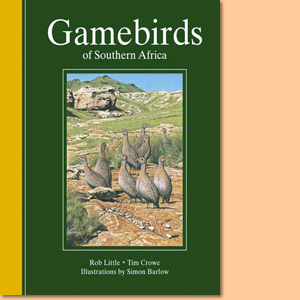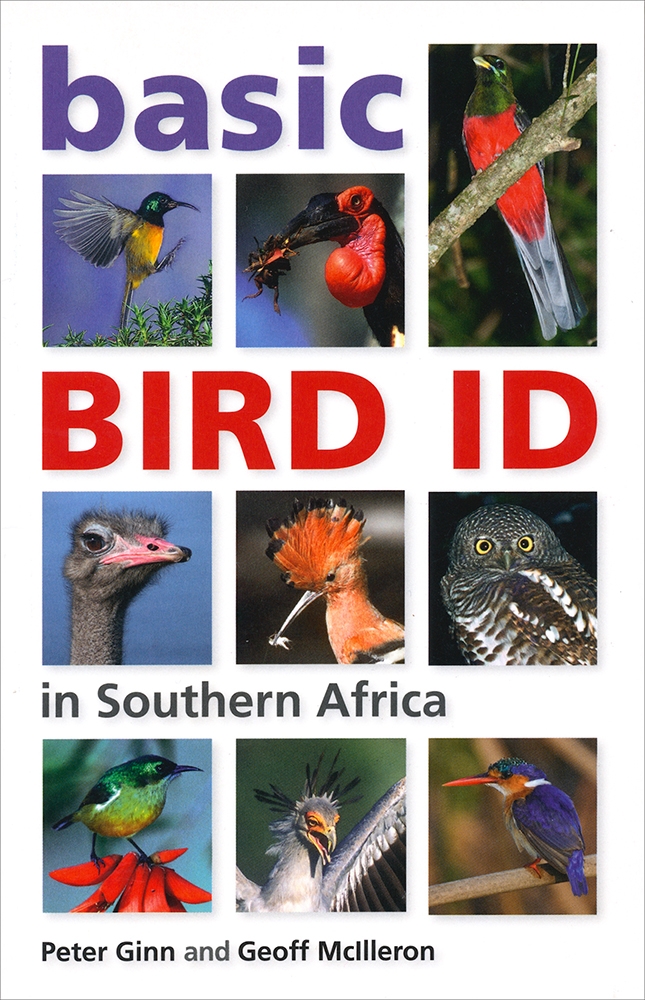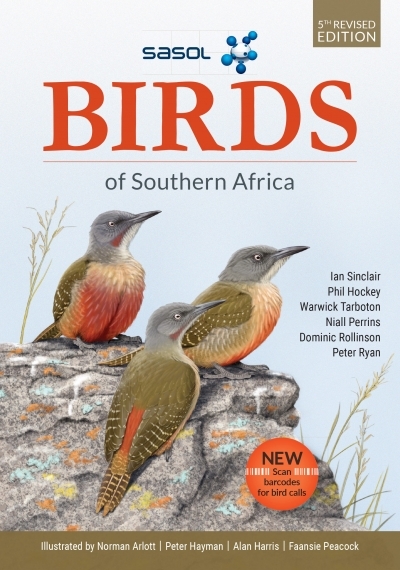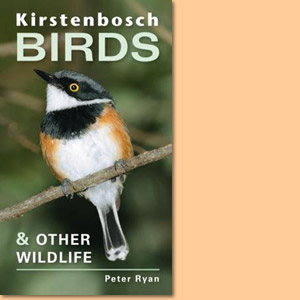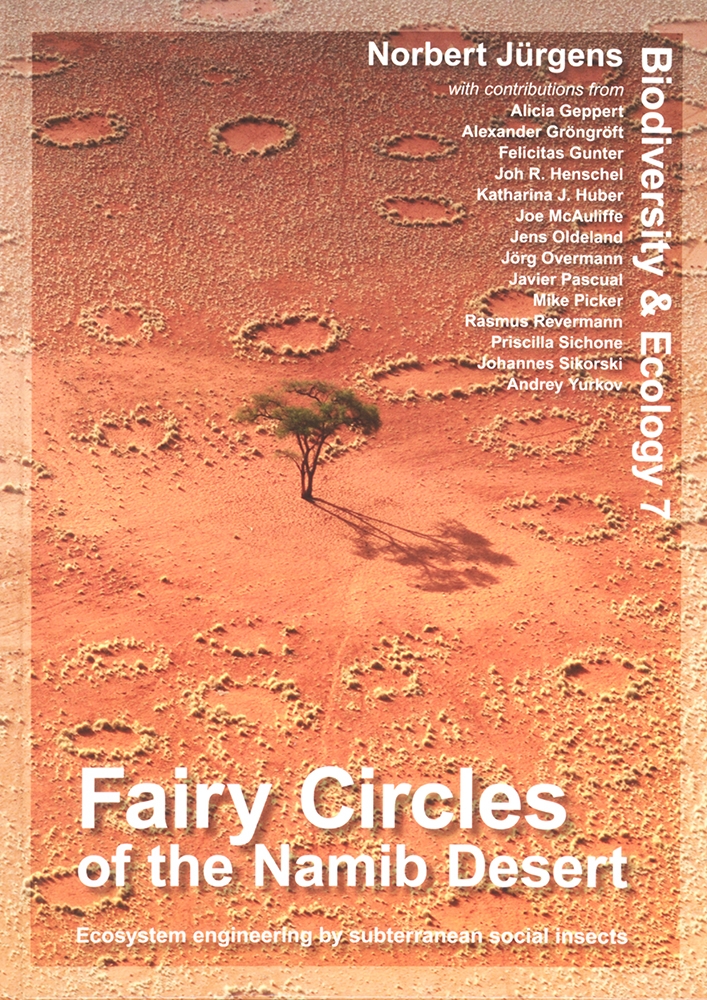Gamebirds of Southern Africa, by Rob Little, Tim Crowe and Simon Barlow
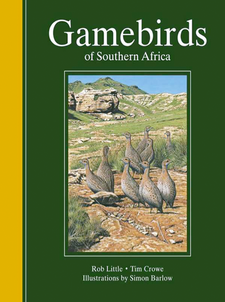
Gamebirds of Southern Africa, by Rob Little, Tim Crowe and Simon Barlow. ISBN 9781770079892 / ISBN 978-1-77007-989-2
Gamebirds of Southern Africa will be a worthy addition to ornithological literature and to the bookshelves of bird enthusiasts, art lovers, and anyone with an interest in nature and conservation. Authors are Rob Little and Tim Crowe, paintings by Simon Barlow.
Simon Barlow Rob Little Tim Crowe
Broadly speaking, gamebirds are those bird species that humans have utilised in numbers for food and sport since prehistoric times because they can withstand 'sustainable harvesting' year after year. This is a familiar, yet often under-appreciated, bird group, members of which can be seen along roadsides, on urban fringes and even within cities, towns and gardens. All gamebirds can be divided broadly by habitat into two artificial groups, landfowl and waterfowl (regardless of whether they are close evolutionary relatives or not). Both groups have representatives on all continents except Antarctica. Recently a duck-like, fossil waterfowl Vegavis iaai was discovered in Antarctica that lived alongside dinosaurs during the Cretaceous period some 65 million years ago, making gamebirds the only cosmo-continental group of birds. Modern waterfowl, such as ducks and geese (Anatidae) and snipe (Gallinago species), are strongly dependent on aquatic habitats. The landfowl such as pheasants (Phasianidae), quails (Coturnix species), grouse (Tetraonidae), partridges (Perdix species), francolins (Peliperdix, Dendroperdix and Scleroptila species), spurfowls (Pternistis species), guineafowls (Numididae), sandgrouse (Pterocles species), bustards (Otididae) and pigeons (Columbidae), occupy virtually all terrestrial habitats ranging from lowland deserts and tropical rainforests to Siberian tundras and the snowy slopes of the highest mountains of the Himalayas. The 21 landfowl species found in southern Africa fall into four groups: francolins and spurfowls (12 species), quails (three species), guineafowls (two species) and sandgrouse (four species). Much research has been conducted into these birds over the past two centuries. In Gamebirds of Southern Africa, we have attempted to summarise this large, but scattered, body of scientific work and to present it as accessibly as possible. The illustrated plates that accompany each of the species accounts were created by Simon Barlow, and took a full two years to complete, involving intensive study of the birds in their natural habitats in consultation with students, farmers and wingshooters. As a result, the illustrations convey in accurate detail the typical habitats in which each species may be found. Landfowl are chicken-like species in the avian taxonomic order Galliformes. Traditionally, the order Galliformes is divided into nine major groupings: megapodes, cracids (guans, chachalacas and curassows), guineafowls, grouse, turkeys, pheasants, partridges (including francolins and spurfowls), Old World quails and New World quails (see Table 1 & Figure 1a). Megapodes, confined to the tropical and subtropical regions of Australasia, and cracids, restricted to South America, are the most ancient galliforms. Megapodes have, as their name implies, large feet and differ from all other birds in that their eggs are incubated artificially, for example by heat from rotting vegetation piled in a compost-heap-like nest or by sand heated by volcanic activity. Cracids differ from the other galliforms in that they spend relatively little time scratching on the ground for food, preferring rather to pluck fruits and flowers from the branches of trees or to pick up fallen items from the ground. Now that it is possible to examine DNA in addition to the anatomy of both living species and fossils, as well as plumage, calls and behaviour, it is apparent that a third major evolutionary break in the galliform evolutionary tree created the African guineafowls. The evolution of these three ancient groups of galliforms on well-separated continents was precipitated by the break up of the megacontinent Gondwana into Australasia, South America and Africa more than 90 million years ago. After that, the evolutionary story becomes more complicated. About 55 million years ago partridge/francolin-like galliforms dispersed from Africa to North America and Asia, giving rise to the rest of Earth's gamebirds: quails, partridges, peafowls, junglefowls, pheasants, turkeys and grouse. The ancestors of the American descendants are still, relictually, represented in Africa by the evolutionarily enigmatic Stone 'Partridge' Ptilopachus petrosus, which is found in African savannas north of the tropics, and by Nahan's 'Partridge' Ptilopachus nahani in forests in the Democratic Republic of the Congo and Uganda. [...]
This is an excerpt from the book: Gamebirds of Southern Africa, by Rob Little, Tim Crowe and Simon Barlow.
Book title: Gamebirds of Southern Africa
Authors: Rob Little; Tim Crowe
Illustrator: Simon Barlow
Imprint: Nature
Publisher: Random House Struik
Cape Town, South Africa 2011
ISBN 9781770079892 / ISBN 978-1-77007-989-2
Hardcover, 25x29 cm, 136 pages, throughout colour illustrations
Little, Rob und Crowe, Tim und Barlow, Simon im Namibiana-Buchangebot
Gamebirds of Southern Africa
This new edition of Gamebirds of Southern Africa has been updated and subtly redesigned, but still adheres to the original standards of excellence.
Weitere Buchempfehlungen
Basic Bird ID in southern Africa
Basic Bird ID offers a down-to-earth system for newcomers to the field of birding.
Sasol Birds of Southern Africa
Sasol Birds of Southern Africa remains the region’s most comprehensively illustrated and trusted field guide.
Kirstenbosch Birds and Other Wildlife
Kirstenbosch Birds and Other Wildlife is a compact guide to the birds and other wildlife of the National Botanical Garden at Kirstenbosch, South Africa.
Fairy Circles of the Namib Desert: Ecosystem engineering by subterranean social insects
Fairy Circles of the Namib Desert: Ecosystem engineering by subterranean social insects. Biodiversity & Ecology, Volume 7

